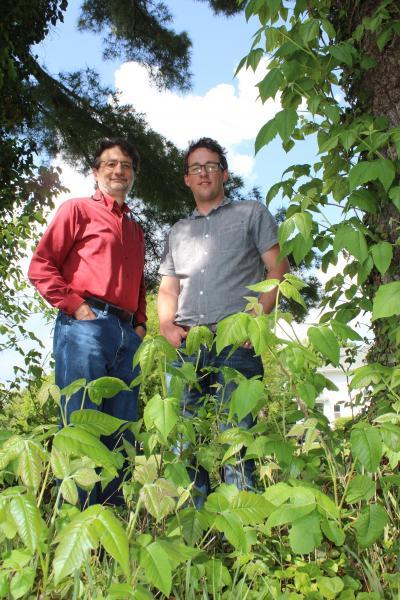One of the hazards of summer is picking up an itchy poison ivy rash but researchers say they have found a natural and effective way to kill it - a fungus named
olletotrichum fioriniae
that grows on the fleshy tissue surrounding the plant's seed.
For being so annoying, poison ivy has had surprisingly little research done on it. John Jelesko, an associate professor of plant pathology at Virgina Tech, began studying the plant after experiencing a nasty poison ivy rash himself while doing some yard work. He found that most of the work was focused on urushiol, the rash-causing chemical found in the plant's oils. Urushiol is extremely potent. Only one nanogram is needed to cause a rash, and the oil can remain active on dead plants up to five years.
But rather than focusing on urushiol, Jelesko set about studying ways to kill the plant itself. He worked with Matt Kasson on the project, a senior research associate in the same department.
"This poison ivy research has the potential to affect the untold millions of people who are allergic to poison ivy," said John Jelesko, a Fralin Life Science Institute-affiliated faculty member. "We have the makings of a nonchemical way to control an invasive plant that can be used by homeowners and others who manage outdoor sites."
Their work is especially valuable in light of the fact that a 2006 study showed that as the planet warms, poison ivy is predicted to grow faster, bigger, and more allergenic, causing much more serious reactions that could send an increasing number of people to the doctor for prescription medications.

John Jelesko and Matt Kasson. Credit: Virginia Tech College of
Agriculture and Life Sciences
"When poison ivy can't be treated with over-the-counter treatments and requires an outpatient visit, then we are talking about a public health concern that is very real,” said Kasson.
The research team discovered the killer fungus in their initial attempts to generate microbe-free poison ivy seedlings to use in their studies. Jelesko noticed that not only were some of the seeds failing to germinate, but on the seedlings that did germinate, there was a blight wiping out the young seedlings. Jelesko enlisted the help of Kasson to isolate what he suspected was a fungus causing disease in the plants. The team discovered that the fungus was growing on all the plants that died and the seeds that didn't germinate.
The fungus caused wilt and chlorophyll loss on the seedlings just by placing it at the junction of the main stem and root collar of the plant at three weeks post-inoculation. At seven weeks post-inoculation, all but one of the plants had died.
Though herbicides are available to kill poison ivy, Jelesko and Kasson said that if this fungus were developed into a commercial application, it would not only be more effective than its chemical counterparts, but also has the benefit of being completely natural.
"We have to keep in mind that the chemicals used to control poison ivy are general herbicides, meaning that they will affect and probably kill many other plant species, so their use in large areas is not always practical," said Thomas Mitchell, associate professor of fungal biology and molecular genetics at Ohio State University who is familiar with the research but not affiliated with it. "This work shows promise for an alternative approach to the use of chemicals and has great potential as a biological control alternative. This type of approach, using native pathogens to control noxious and invasive plants, is gaining more much deserved recognition."
Kasson, whose research is funded by the U.S. Department of Agriculture Forest Service, believes it would be relatively simple to develop a soil granular to spread on top of poison ivy-infested areas in yards and recreational areas such as campgrounds to naturally infect the plants and kill them.
After Kasson successfully isolated the fungus in pure culture from infected plants, a DNA analysis revealed that the fungus — Colletotrichum fioriniae — is also widely known as an insect pathogen that kills an invasive bug that infests and kills hemlock trees.
In all of the natural world, only humans are allergic to poison ivy and its itch-inducing oil, urushiol.
"Humans appear to be uniquely allergic to urushiol," said Jelesko. "Goats eat it, deer eat it, and birds eat the seeds, all to no ill effects."






Comments